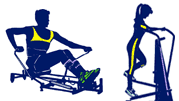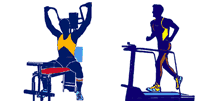|
WHAT YOU SHOULD KNOW ABOUT WEIGHT SELECTION PINS
Virtually all selectorized weight machines, whether they are universal gyms or single station strength units, have weight selector pins that get inserted into the weight stack and pass through the selector rod to choose the number of weight plates to be lifted.
There are several different styles of weight pins, often called weight selector keys, that are specific to particular brands and models of strength equipment. They are not necessarily interchangeable. The manufacturers choose the style that will work safely with their gym equipment.
Some of the older weight keys were "L" shaped and had
a hump in the middle of the long section or a short bar welded on top of
the long section that was designed to lock into a port the bottom of the
cast iron weight plates that were used on the gym. A Universal Centurion
gym used that type of weight selection key. Once locked in place, it couldn't
fall out of the weight stack because it had to be turned ninety degrees to
be extracted.
Most home gyms and commercial strength units made today
have steel weight plates that have a straight hole through the center of
each weight plate to receive the weight selector pin. These take weight pins
that are straight round shafts about four to five inches long with a knob
or t-handle on one end. At first glance, they may not appear to have significant
differences, but the shafts come in different lengths, different diameters,
some have detent balls and some have magnetic knob that hold them firmly
in place against the selected weight plate.
Those locking selector pins that have detent balls
near the end come in two varieties. One design allows the detent balls (
small spring load BB's that lock the shaft into with weight plate ) to be
depressed just by the force needed to insert the pin into the weight stack.
The other design has a push button on the handle that must be depressed in
order to allow the detent balls to release.
Others weight pins are just plain shafts with a knob
on one end. This style offers the poorest grip on the selector rod.
Always use the correct weight selector pin for a particular
piece of equipment. Using the wrong weight key could cause the pin to back
out during use, allowing the weight plates to fall off the selector rod,
resulting in injury to the user. For the same reason, never use bent or damaged
pins, substitutes, like bolts or pins whose detent balls are missing or inoperative.
When trying to find a replacement weight selection pin, you will need to know the brand and model of the gym equipment and if that is not sufficient you will need to know the diameter of the shaft, the length of the shaft, excluding the knob, the "locking space",
the distance from the knob to the detent balls, if so equipped, and whether
or not the knob is magnetic. Weight selector keys that have magnetic knobs
do not have detent pins and vice versa.
Additionally, some weight selector pins come with a
tether to keep them from getting misplaced or used on the wrong equipment.
The tethers are usually a coil of plastic wire that look like a phone cord
or a length of steel cable. In either case, one end of the tether gets permanently
attached to the knob and the other end gets attached to the top of the respective
weight stack or one of the weight guide rods.
Replacing defective weight selector pins is cheap insurance
against injury. It is a good practice for health clubs or other commercial
fitness center, like high school weight rooms, to keep spare selector pins
on hand. A missing selector pin can keep a piece of single station strength
equipment, such as a leg curl machine or a leg extension machine from being
used and may tempt someone into use something inappropriate in place of the
proper weight selector pin.
|





